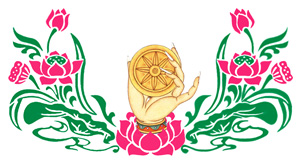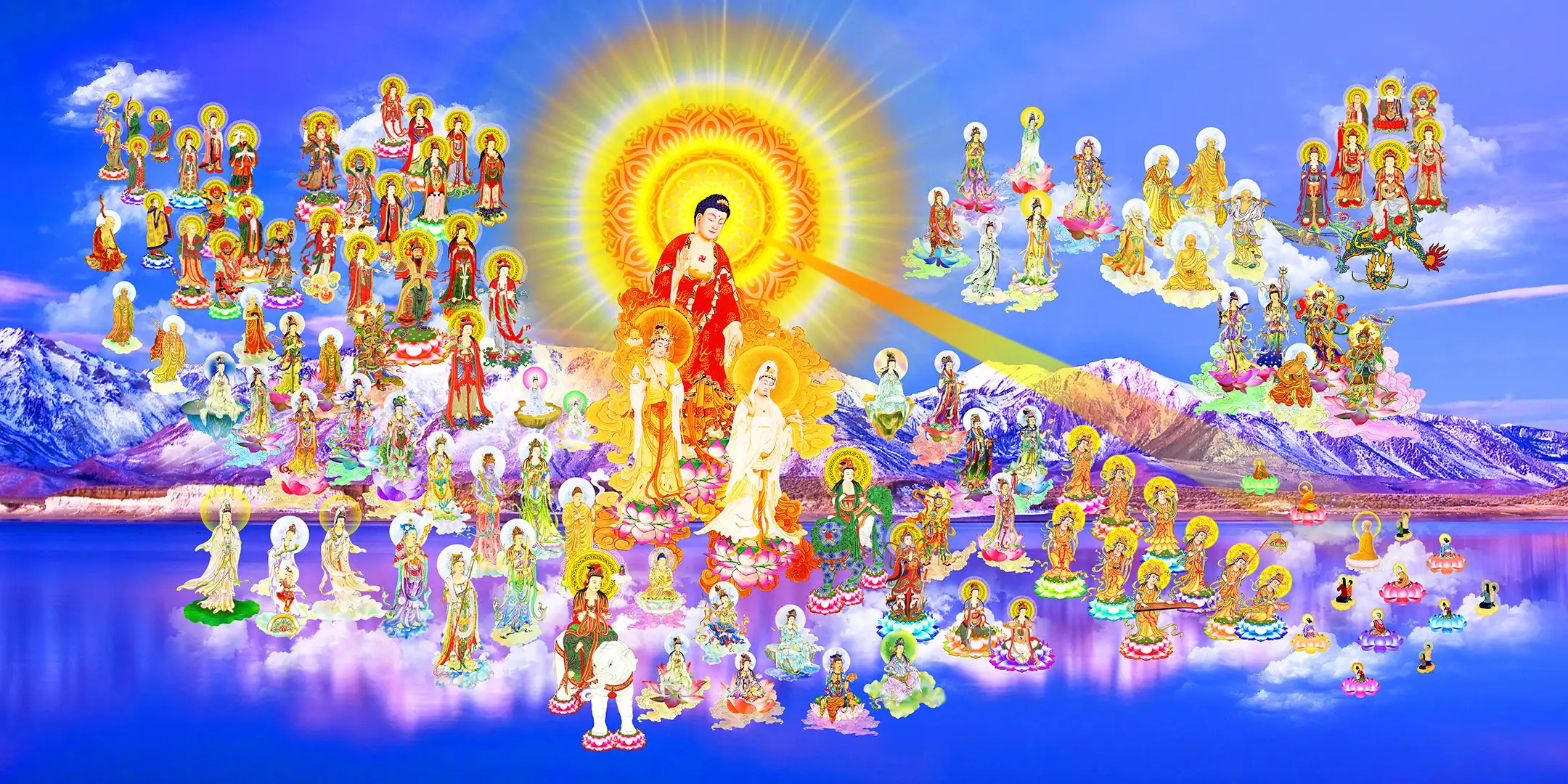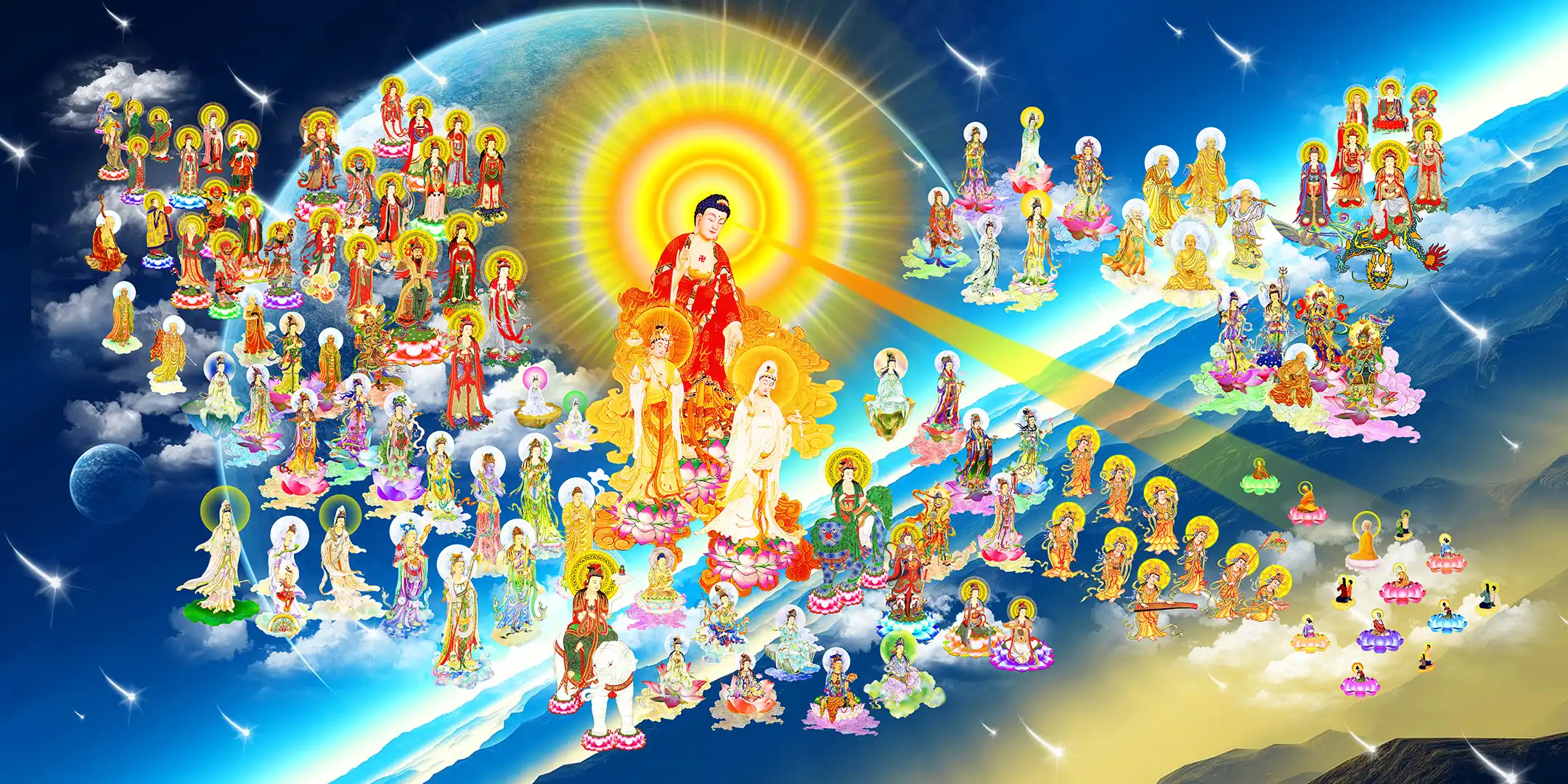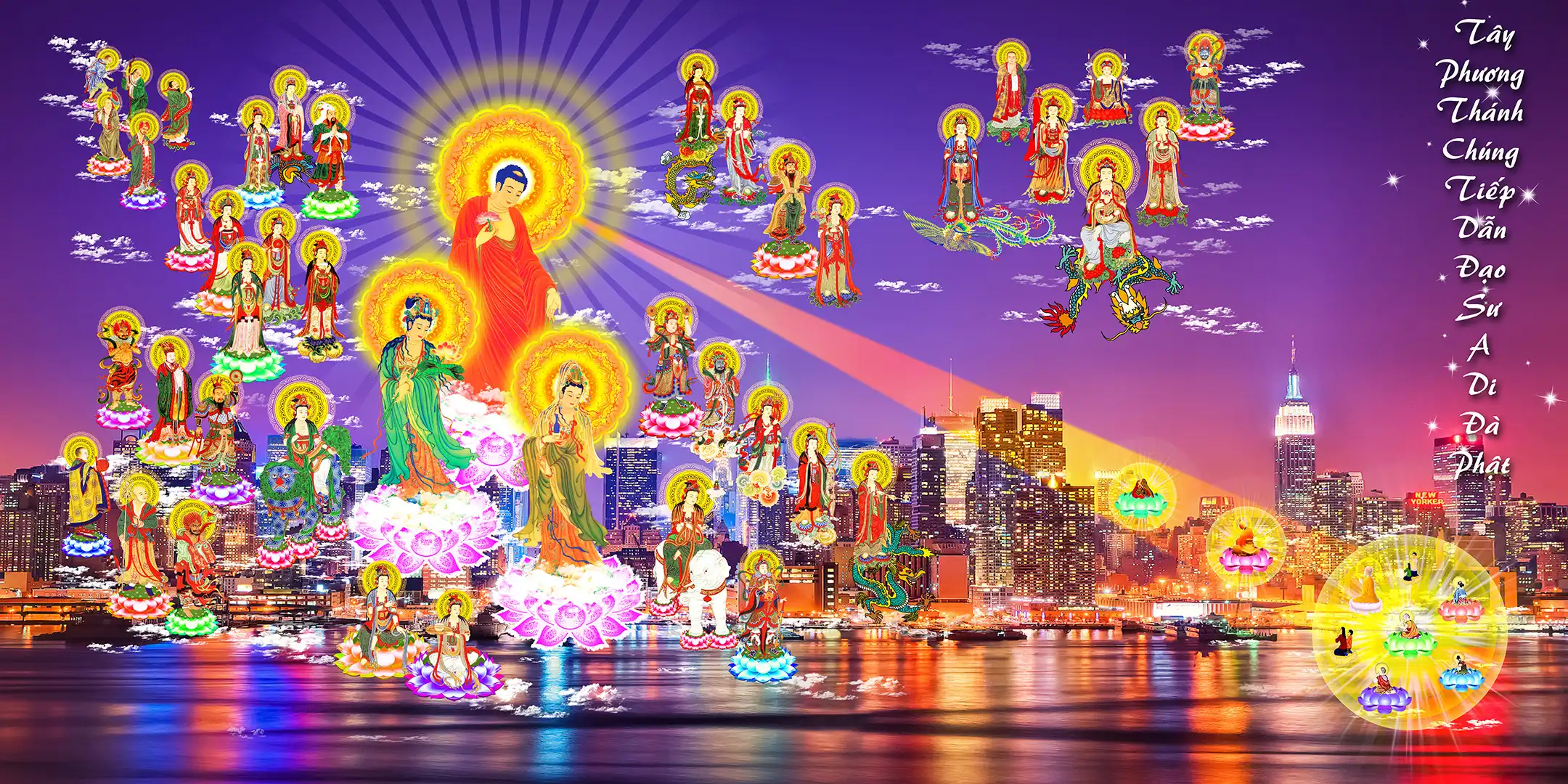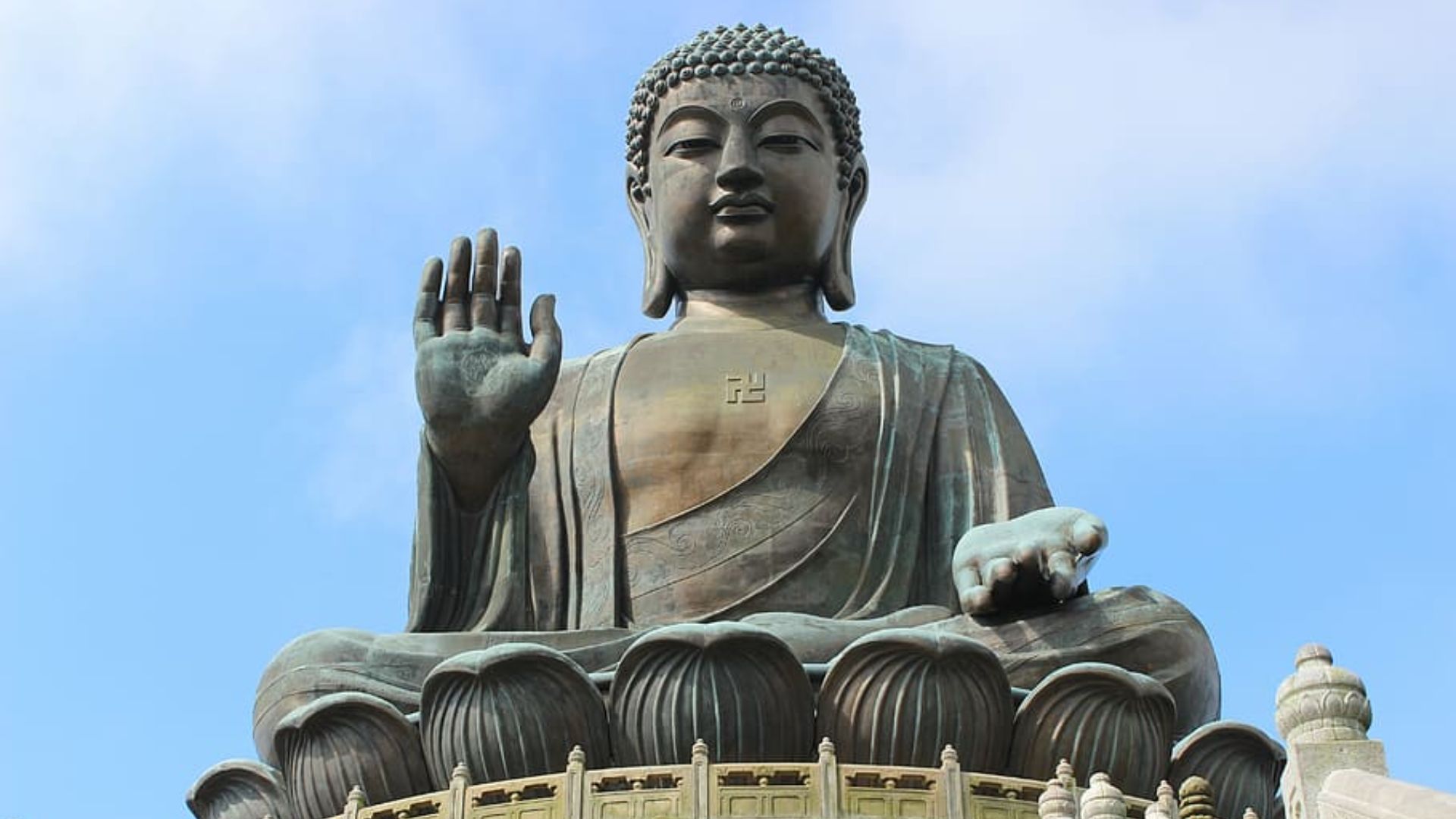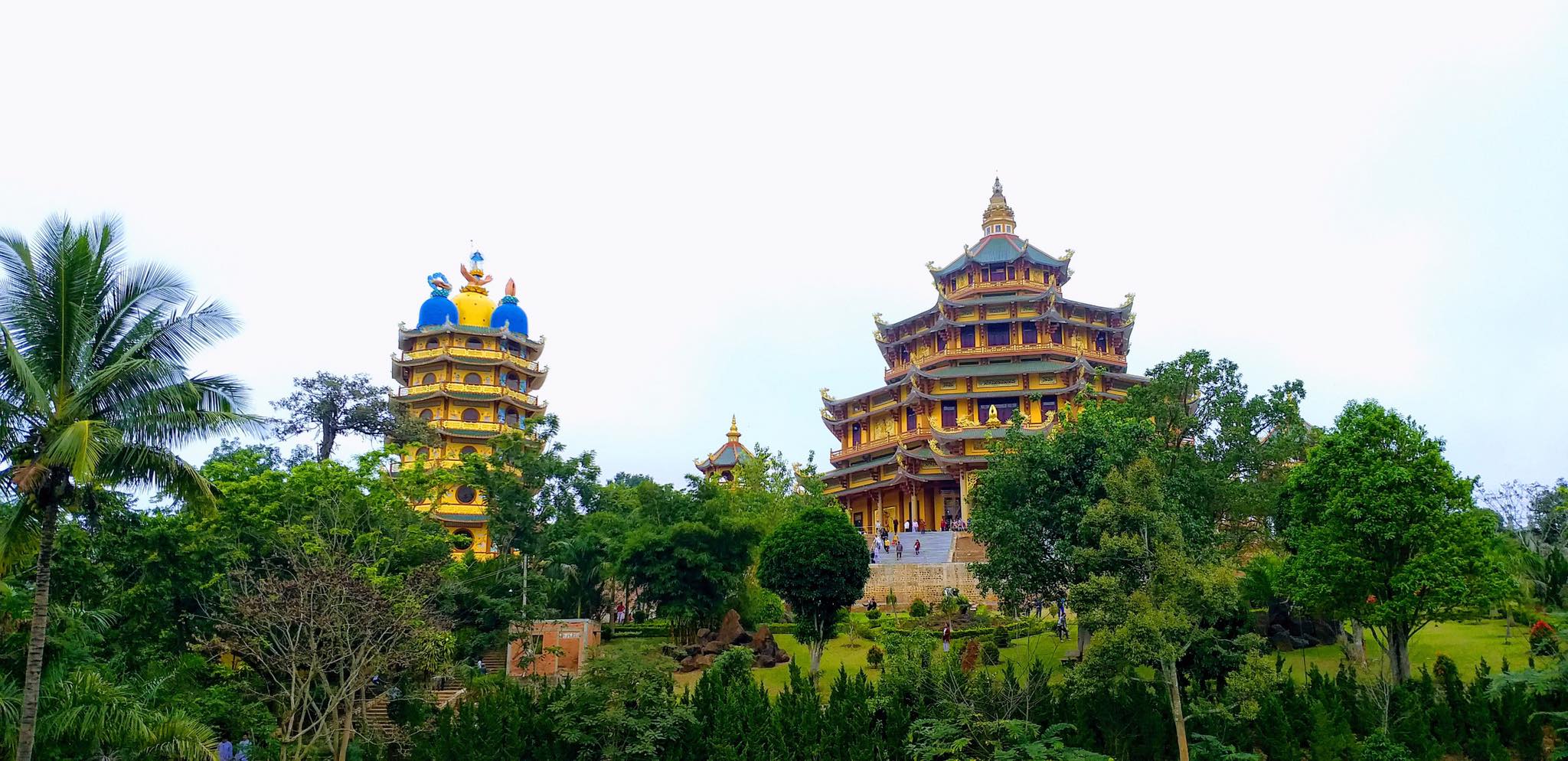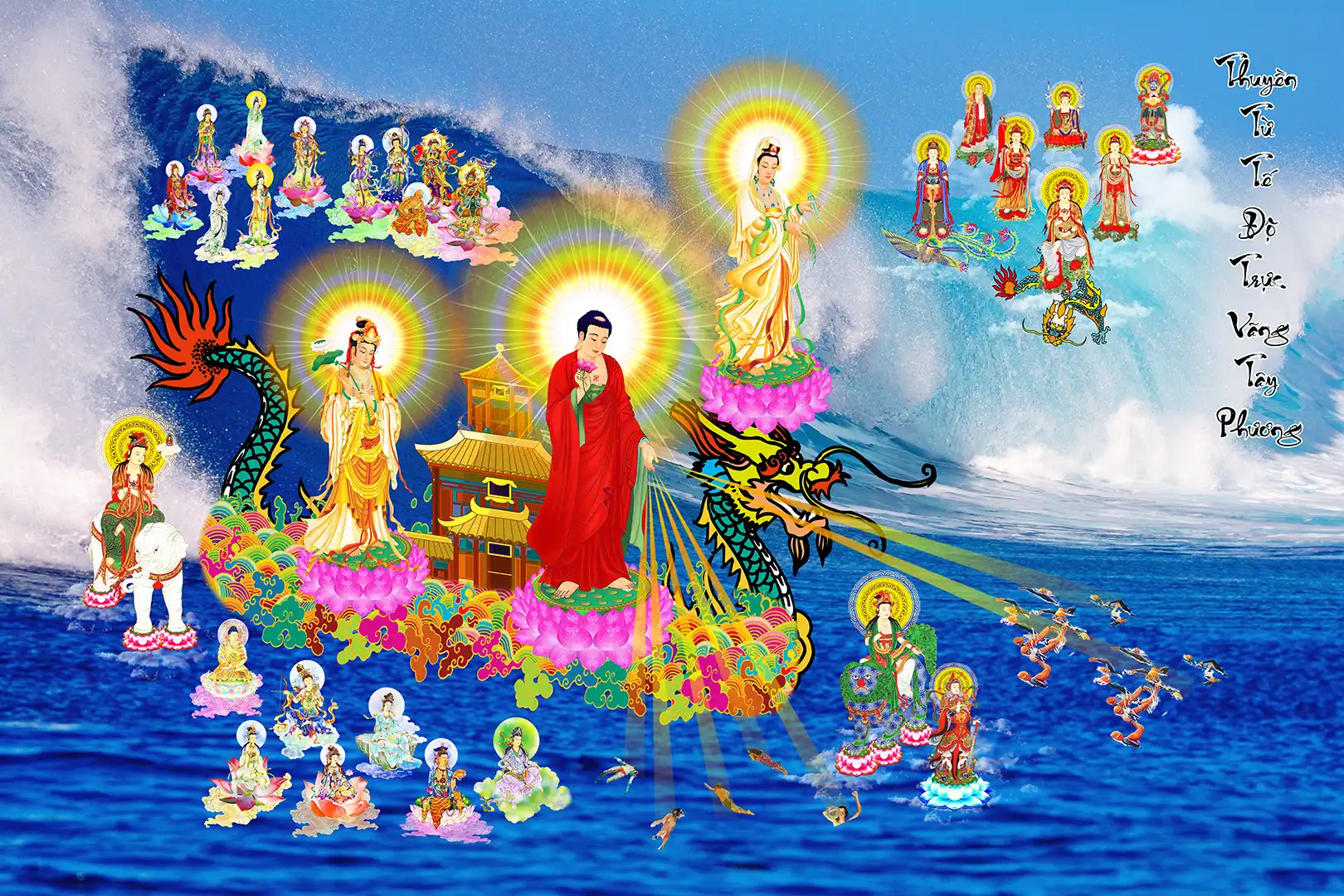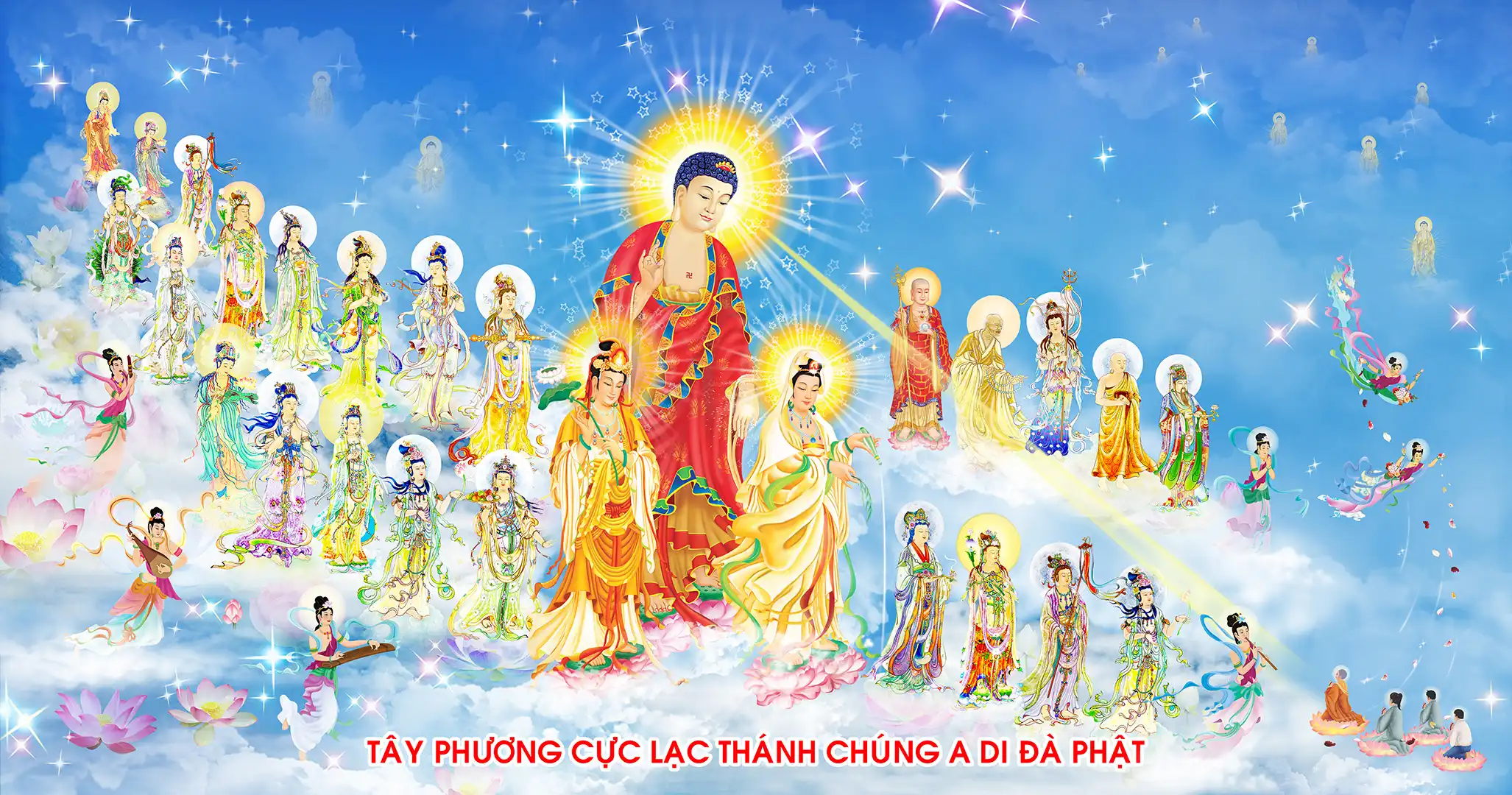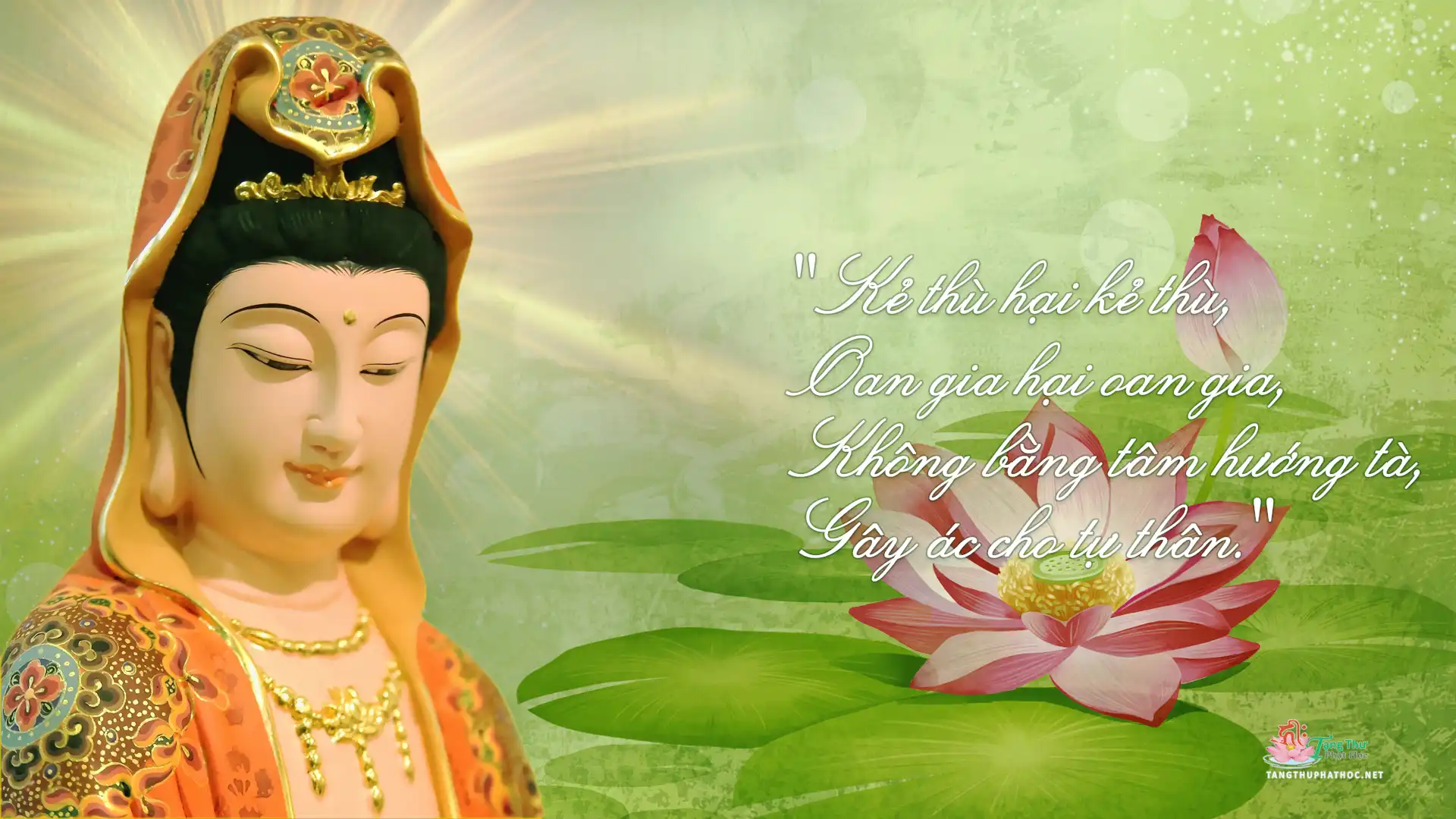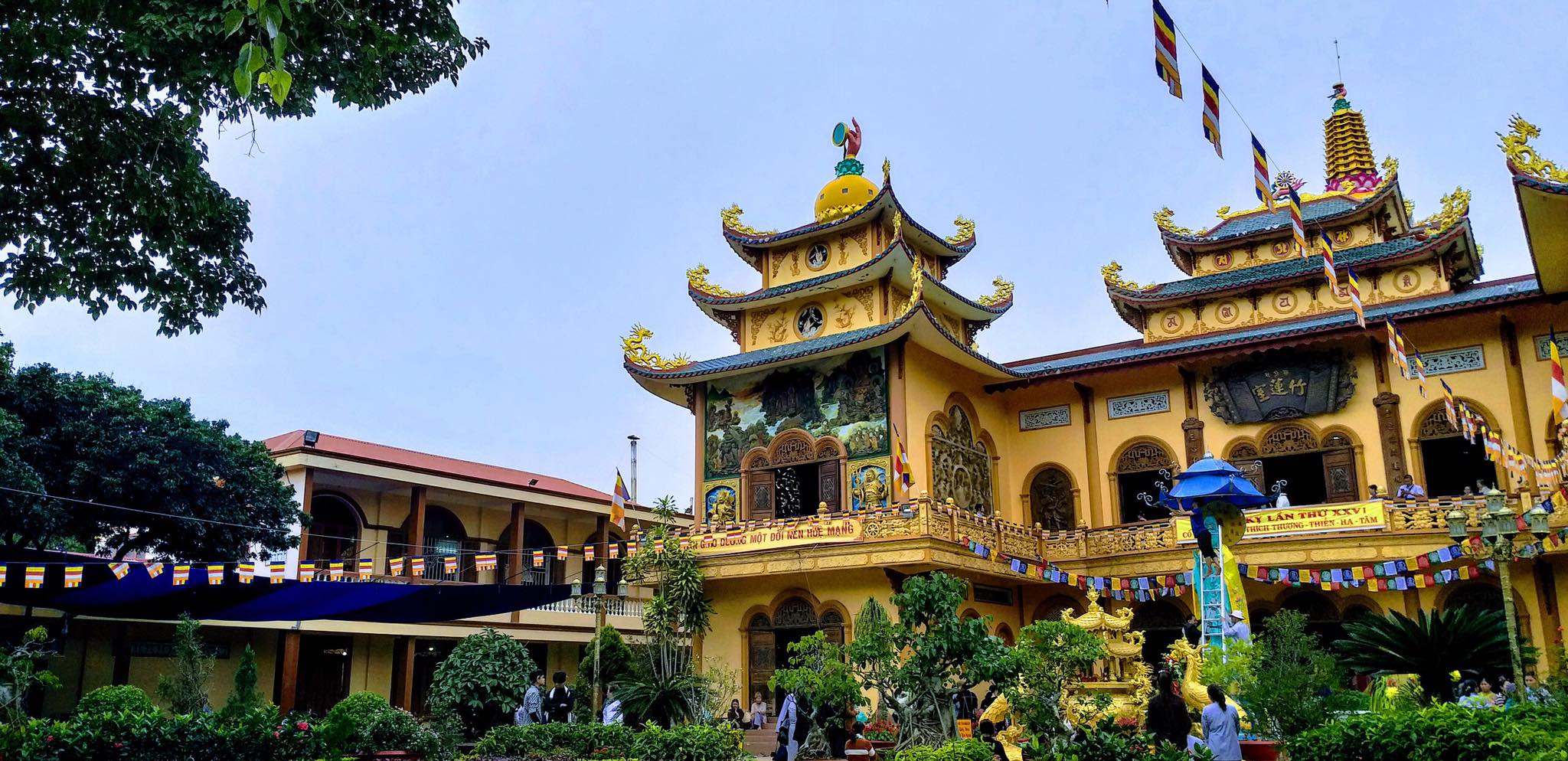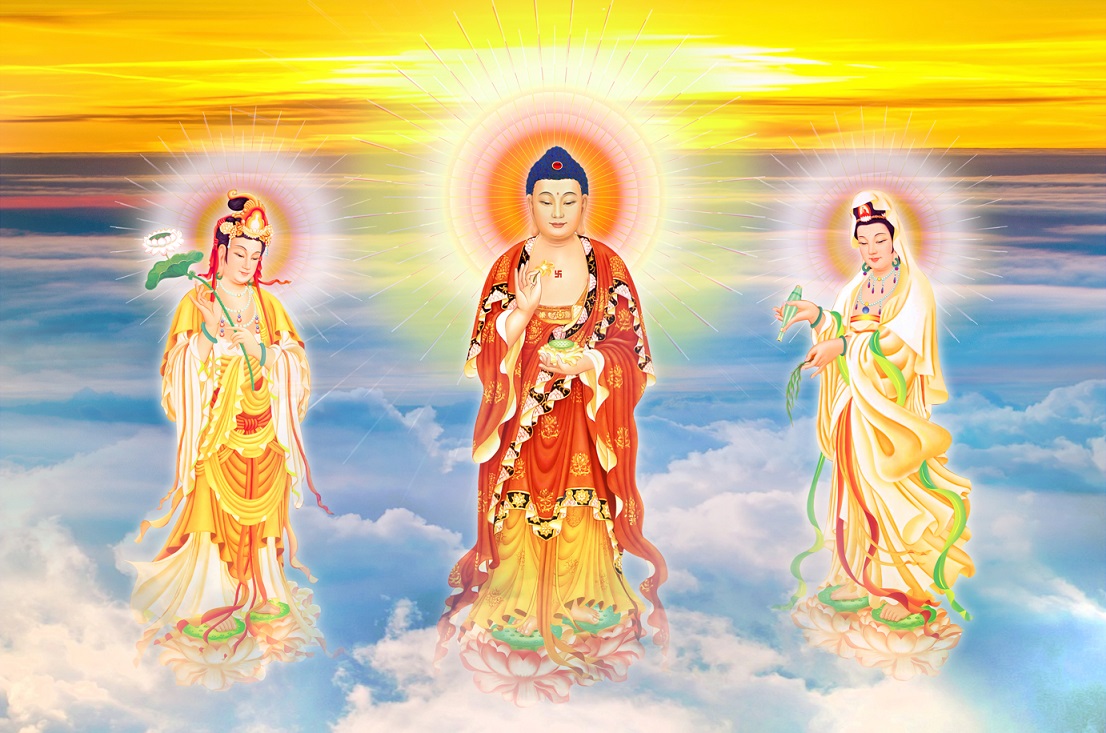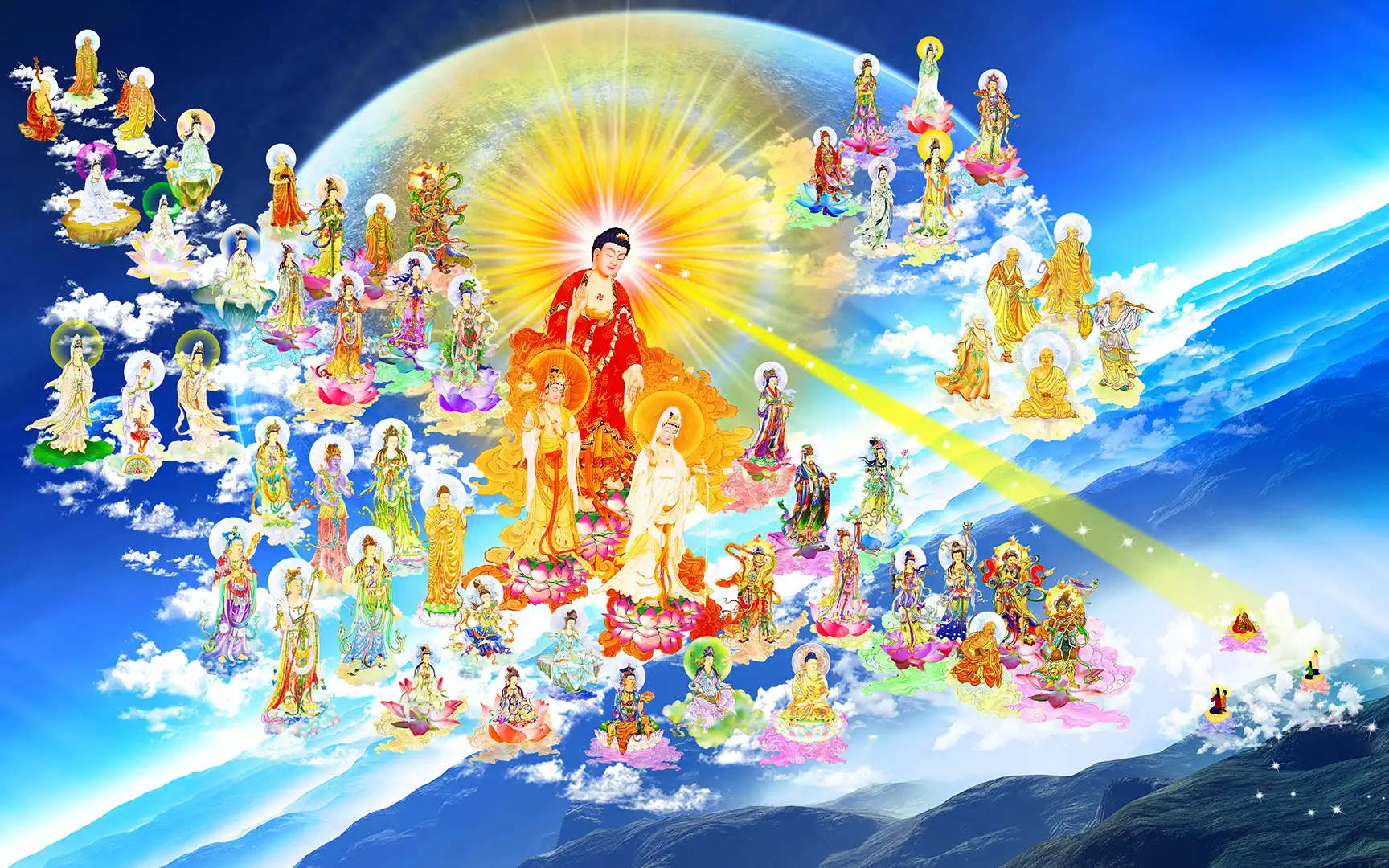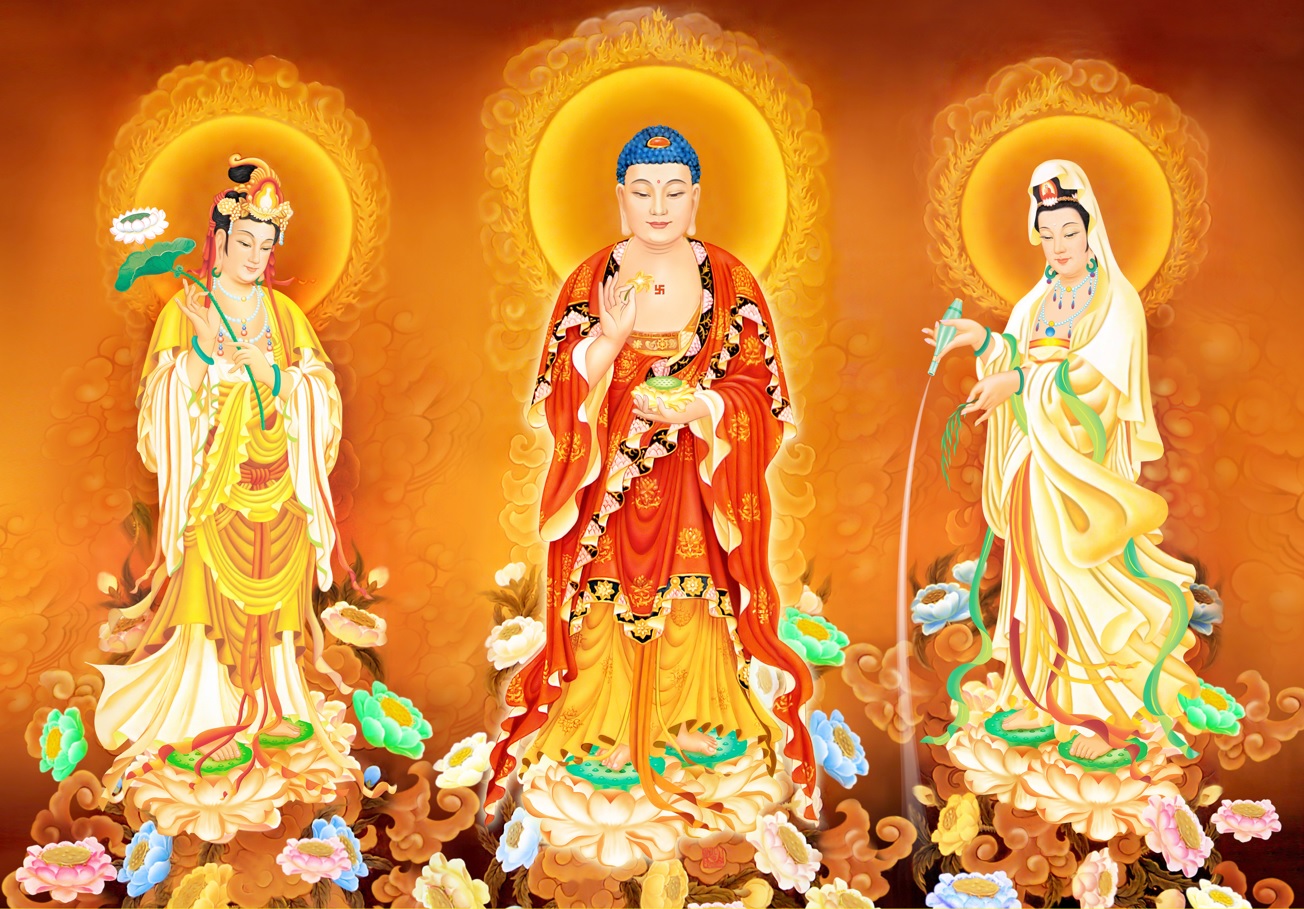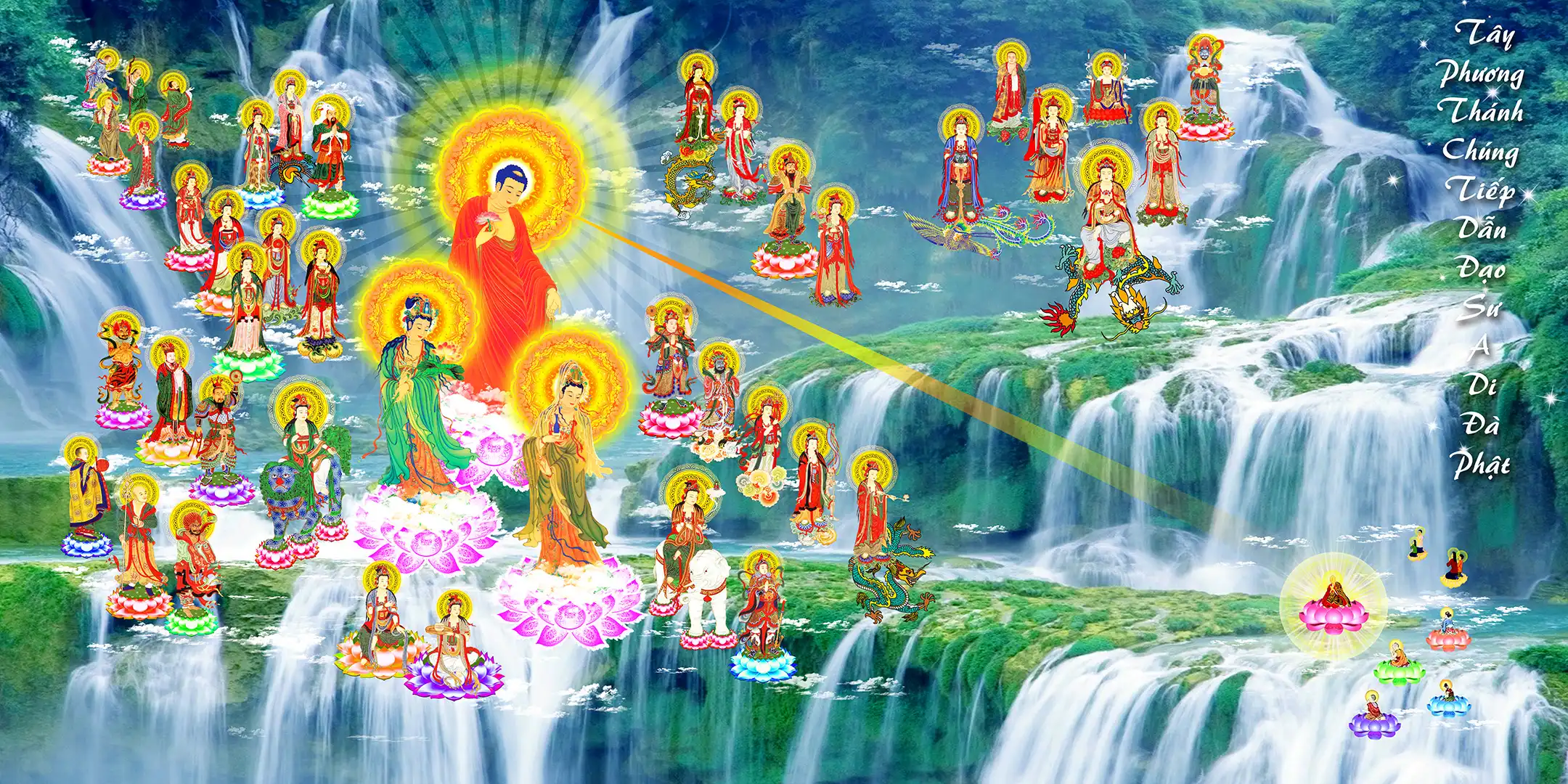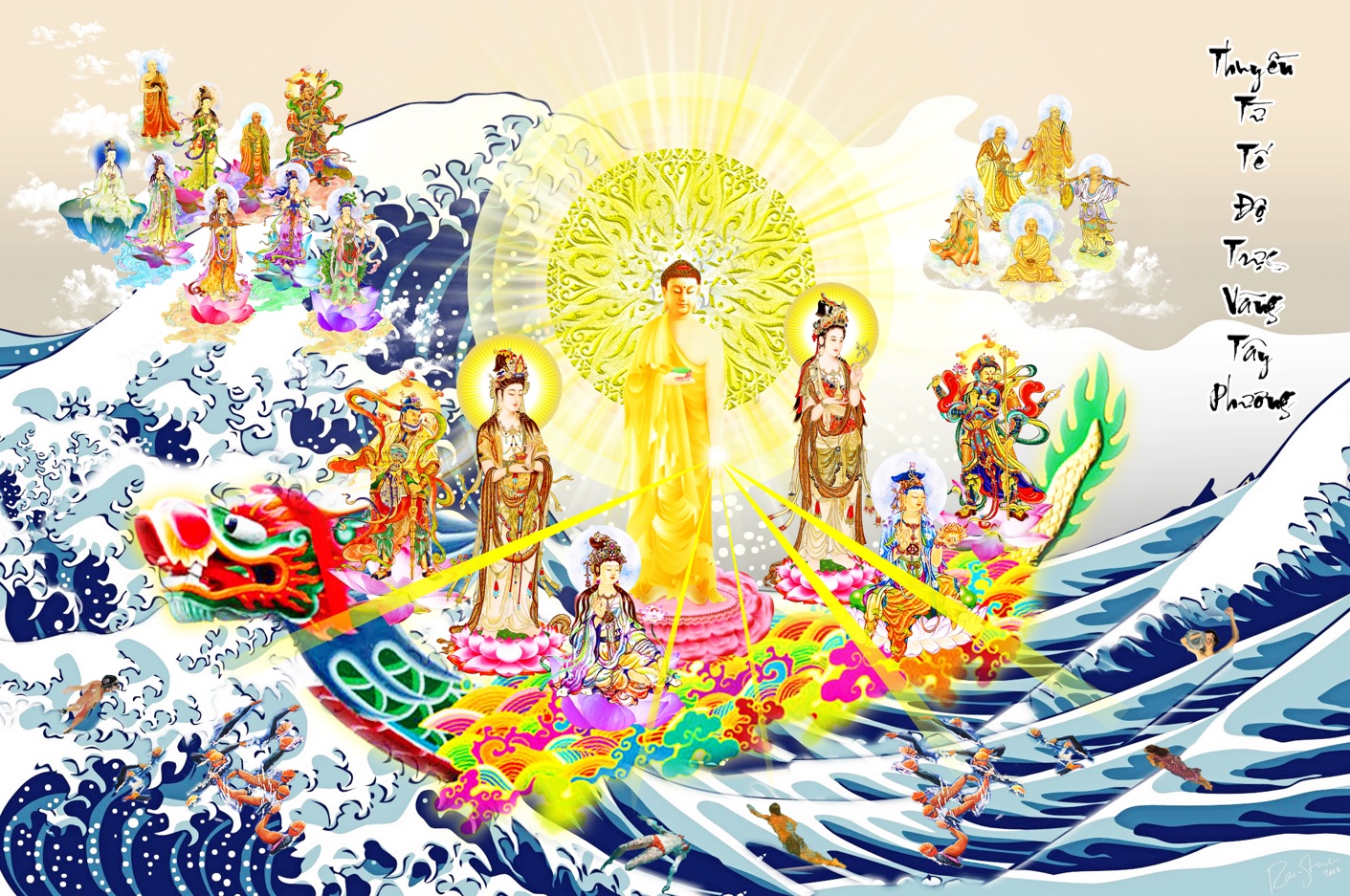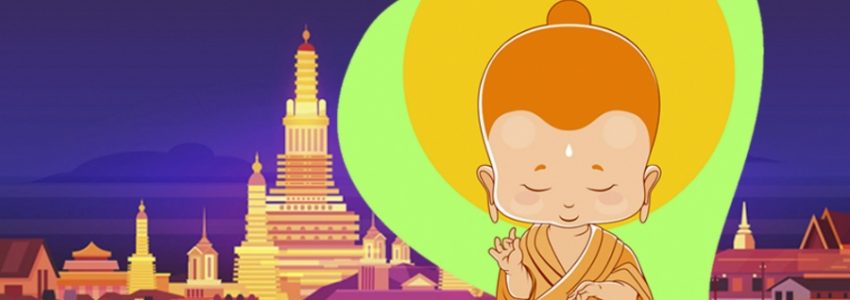THE SORROWLESS FLOWERS
Thiện Phúc
VOLUME I
21. Buddhism and Buddha’s statues and Images
22. Buddhism and the Concept of First Cause
23. The Concept of a Soul in Buddhism
24. Education in Buddhism
25. Buddhism and Ancestor Worship
26. Buddhism and Beauty
27. Is Buddhism Pessimism or Optimism?
28. Buddhism vs Philosophy
29. Buddhism and Science
30. World of Peace and War in Buddhist Point of View
![]()
21. Buddhism and Buddha’s statues and Images
Image is one of the needs to remember the Buddha. However, it is impossible to express the Buddha in physical form because he is nothing but the attributes of awakening, enlightening, wisdom, compassion, loving-kindness, joy, equanimity, etc. However, if we don’t express Him in a perfect statue, what else can we do with these symbols? We should express these symbols in the most ideal human forms, namely in the image of the Buddha when He acquired the ultimate enlightenment. So the Buddha’s image should be in the attitude of calmness and indifference to pleasure and pain. People often feel the need to remember the things they love and respect in a form that they can see. For instance, a photograph is kept in order to remember a loved one. The national flag is a reminder of the loyalty people feel towards their country. The photograph and national flag are examples of symbols in remembrance of the qualities of the people or things that are being represented. They form the focal point of one’s feelings of love, respect and loyalty. In the same way, the shrine found in Buddhist homes or monasteries is a focal point of Buddhist observances. At the center of the shrine, there is usually an image of the Buddha. The image may be made of a variety of materials such as marble, gold, wood or clay. The image is a symbol that helps to remember the noble qualities of the Buddha. The shrine may also have such objects as a volume of Buddhist scripture to represent the Dharma. Some shrines may display other items such as images, pictures or photographs of Buddhist monks and masters to represent the Sangha. When Buddhists stand before a shrine, the objects they see on it help to remind them of the qualities that are found in the Buddha and the Sangha. This inspires them to work towards cultivating these qualities in themselves.
According to Prof. Junjiro Takakusu in The Essentials of Buddhist Philosophy, none of the earlier sculptures of sanchi and Barhut represent the Buddha in huma figure. It is remarkable to us that the principle events of the Buddha’s life have been fully given in sculture without a figure of the hero. How was that possible? The Buddha at birthis represented by a full blooming lotus; the Buddha in Enlightenment by the Bodhi tree with a rail around it; the Buddha in his first preaching by a wheel, above which a tri-ratna mark is sometimes added; the Buddha in his beggng round, or mendicancy, by a bowl; and the like. If suggestion be a means of true art, the early Buddhist artists understood it perfectly and utilized the idea skilfully for practical purposes. However, all this does not necessarily mean that the elders did not represent the Buddha at all during his lifetime, for there is a legend which tells of their making an image for the purpose of offering veneration during the Buddha’s absence. They were formalistic and realistic, and so if the Buddha was actually before them, they had a right to depict him in painting or sculture. Now that he had passed into Nirvana, however, it was improper to represent the one who no longer really lived. It was after a considerable development of the Gandhara art that the southern school of Buddhism began to have images of Buddha. This was believed at about the same time when the Buddha’s teachings were committed to writing, i.e., 80 B.C. The elders of idealistic and free-thinking tendencies, whom we might regard as the foreunners of the Mahayana, would not hold any meetings for the rehearsal of the Buddha’s sermons, nor would they enlarge upon their Vinaya rules beyond what was laid down by the Buddha himself. They would commit those sacred words to memory or to writing as they pleased. They did not hesitate in using their talents in painting or sculture to depict the Buddha’s image according to their own ideal of beauty and perfection, as they did in the Gandhara art. The trend of the free-thinking mind can also be seen in the metaphysical treatises of the Optionalists (Vaibhasikas), in which several opinions about dharmas or higher dharmas (abhidharmas) are gathered together and some optional ones have been selected and recommended for study. Though the Vaishasika School belonged to the Hinayana, it already betrayed a tendency toward the free-thinking school. Such free-thinking people would be bold in exegesis, erudition, annotation, or in forming and expressing opinion. This, however, does not mean that they departed from the original teachings of the Buddha.
Nowadays, besides the two great statues of the Buddha in Afghanistan which were destroyed by the Taliban in 2002, there are still several big Buddha statues in the world, among them are the two most famous statues in Japan: 1) a huge statue of Varocana housed in the Todaiji Temple in Nara, commissioned (ủy thác) by emperor Shomu (724-748), it was consecrated (dâng cúng) in 751; and 2) an image of Amitabha Buddha, which was financed by donations gathered by Joko and constructed in 1252. It was originally housed in Kotokuin Temple, but the building was destroyed by a tidal wave in 1495. The image was left intact, but an earthquake in 1923 damaged its base. Extensive repair work was conducted on it in 1960-1961.
22. Buddhism and the Concept of First Cause
If one posits a first cause, one is justified in asking for the cause of that “First Cause”, for nothing can escape the law of “condition and cause” which is patent in the world to all but those who will not see. However, a man who attributes beings and events to an omnipotent Creator-God would emphatically say: “It is God’s will, it is sacrilege to question the Authority.” Does not this God-idea stifle the human liberty to investigate, to analyze, to scrutinize, to see what is beyond this naked eye, and so retards insight. It is important to understand that craving is not regarded as the First Cause; for according to Buddhism, there is not First Cause, but beginningless causes and effects and nothing else ruling the universe. Things are neither due to one single cause nor are they causeless, but according to the formula of Dependent Arising, things are multiple caused. Craving, like all other things, physical or mental, is also conditioned, interdependent and relative. It is neither a beginning nor an end in itself. Though craving is cited as the proximate cause of suffering, it is not independent, but interdependent. Dependent on feeling or sensation arises craving, feeling dependent on contact and so forth.
23. The Concept of a Soul in Buddhism
In Buddhist thought, there is no so-called “Soul”. Birth precedes death, and death also precedes birth, so that the pair follow each other in bewildering succession. There is no so-called “Soul”, “Self”, or “Fixed entity” that passes from birth to birth. Though man comprises a psycho-physical unit of mind and matter, the “psyche” or “mind” is not a soul or self, in the sense of an enduring entity, something ready-made and permanent. It is a force, a dynamic continuum capable of storing up memories not only of this life, but also of past lives. The mind or psyche is no more a fixed entity. The Buddha stressed that the so-called “being” or “individual” is nothing but a combination of physical and mental forces, or energies, a change with continuity. Someone may ask, if there is no transmigrating permanent soul or self to reincarnate, then what is it that reborn? According to Buddhism, there is no permanent substance of the nature of Self or Soul that reincarnates or transmigrates. It is impossible to conceive of anything that continues without change. All is in a state of flux. What we call life here is the functioning of the five aggregates of grasping, or the functioning of mind and body which are only energies or forces. They are never the same for two consecutive moments, and in the conflux of mind and body we do not see anything permanent. The grown-up man is neither the child nor quite a different person; there is only a relationship of continuity. The conflux of mind and body or mental and physical energy is not lost at death, for no force or energy is ever lost. It undergoes change. It resets, reforms in new conditions. With regard to the psychological question, Buddhism does not admit the existenceof a soul that is real and immortal. Anatma or non-self refers to all things (sarva-dharma), organic and inorganic. In the case of human beings, Buddhism believes that there will accordingly to be no soul, no real self that is immortal. While in the case of things in general, there will be no noumenon, no essence which is unchangeable. Because there is no real self spatially, i.e., no substance, there will be no permanent, i.e., no duration. Therefore, no bliss, is to be found in the world.
24. Education in Buddhism
The goal of any Buddhist cultivator is to achieve self-enlightening (examine with one’s own intelligence, and not depending upon another), enlightening or awakening of others, then achieve the final accomplishment, that is to become a Buddha. Devout Buddhists should always remember that the goal of Buddhist education is to help sentient beings become Buddhas, or at least become real Buddhists, and not aiming at socializing human beings as worldly people. Because Buddhism is a religion of returning to self (looking inward), the goal of its education must be inward and not outward for appearances and matters. As mentioned above, the main causes of sufferings and afflictions are greed, anger, hatred, ignorance, pride, doubt, wrong views, killing, stealing, sexual misconduct, lying, and so on… and the ultimate goal of Buddhism is to help sentient beings, especially, human beings to eliminate these troubles so that if we are not able to become a Buddha, at least we can become a real Buddhist. Therefore, the goal of Buddhist education is freeing cultivators from being led by these troubles so that they could see Reality and the Truth as it is. The Buddha taught that man of this present moment is the result of millions and millions of his past thoughts and actions, and not ready-made as a cake or a piece of candy. Man’s character is determined by his own thinking, thus man is not perfect by nature. In order to become perfect, man has to educate and train himself. Among other sentient beings, human beings have the ability to think and to reason, and the intelligence to educate and build their life a better one. However, in order to achieve a better or a perfect life, Buddhist or non-Buddhist has no other ways but educating himself with the five precepts (not killing, not stealing, not committing sexual misconduct, not lying and not drinking alcohol or doing drugs) and the eightfole noble path (right view, right thinking, right speech, right action, right livelihood, right effort, right mindfulness and right concentration)… that is to say education in morality. Besides, the core of Buddhism is the law of “Cause and Effect” so Buddhist education cannot miss this law. Devout Buddhists should always remember that “If this is, that comes to be; from the arising of this, that arises. If this is not, that does not come to be; from the ceasing of this, that ceases.” Buddhist education helps point out to everybody that the law of “Cause and Effect” is for everybody, from normal people to saints. If you sow good deeds, you’ll reap good results. In the contrary, if you sow bad deeds, you’ll reap bad results without any exception. Therefore, according to the Buddhits education, whichever causes increases of greed, anger, ignorance, pride, doubt, wrong views, killing, stealing, sexual misconduct, lying… is bad and we should stay away from; and whichever helps decreasing or stopping the above mentioned troubles is good and we should pursue. Whatever we say, devout Buddhists should always remember that Buddhism is not a mere system of doctrine, it is a way of life. If we educate ourselves the way the Buddha taught, we would surely have a peaceful, mindful and happy life.
Buddhists always need two ways of education. The first way is secular education and the second one is religious education. These two ways are considered as the two wings for a bird. Without two wings, no bird can fly. Similarly, without these two ways of education, Buddhists would lead to a poor and obscure life, not only in the secular world but also in the spiritual life. Secular education will help us with an appropriate profession to support our family while religious education will help us lead a true happy life. As a matter of fact, religious education is extremely necessary, for it teaches us how to think and act in order to be good and happy. Besides, it also helps us love and understand the meaning of life so that we are able to adjust ourselves to its laws in any circumstances. After experiencing six years in ascetic practices, the Buddha advised his followers to follow the middle path. He taught: “Buddhists should always make best use of their secular life while cultivating the path of true happiness in this world and hereafter.”
25. Buddhism and Ancestor Worship
Vietnamese people have long believed in the existence of the soul or consciousness after death. Ancestors are thought to watch over and to support their living descendants. Thus, living descendants always worship their ancestors with ultimate respect. Vietnamese people celebrate death anniversary, not only for their deceased parents, but also for their grand-parents, great grand-parents, and great-great grand-parents. They can celebrate with a party or with the simpliest ancestral ritual of burning incense and bowing before their ancestors’ altars or before their ancestors’ portraits. In some families, beside placing offerings of food and drink in front of the altar, they also have the custom to burn paper money for their ancestors. In addition, in some areas in Central Vietnam, there still exist some Clan Temples which worship ancestors of the same surnames. It is no doubt that ancestor worship has helped our people maintain unity and continuity (maintaining generations). Buddhism always promotes ancestor worship by the practice of chanting sutras for the dead, hoping to relieve their karma.
26. Buddhism and Beauty
Many people, especially people from the western world, have a misconception of Buddhism. They suggest that Buddhism is a religion of pessimism. They suggest that Buddhism stresses on impermanence, suffering and egolessness so there is no so-called “Beauty” in Buddhism. In fact, the Buddha never criticized “Beauty” in any of his lectures. A Buddhist never avoids objects of beauty, nor does he run away from these things. He only refrains from making them the basis for strong and individual likes and dislikes. He always keeps in mind the Buddha’s Teaching: “Whatever there is in the world, pleasant and lovable, we have a tendency to attach to them, and we develop a dislike towards their opposites.” Keep this in mind, the Buddhist recognizes beauty where the senses can perceive it. But in beauty he also sees its own change and destruction. He always remember what the Buddha said with regard to all component things, that they come into being, undergo change and aredestroyed. Therefore the wise man acquires a great depth of vision. His admiration for the beauty is not coloured by a greed for acquisition and possession. To Buddhists, the shape or color of the face doesn’t matter because it’s only temporary with time. A young, beautiful face of today may someday become an old ugly face with wrinkles and dots all over. To Buddhists, no matter how beautiful or ugly their face may be, they focus on cultivating love, that love will give them an inward eternal charm, a real beauty to all Buddhists.
According to extant records of the earliest Buddhist community, iconographic representation was discouraged by Sakyamuni Buddha and his followers, who wanted to prevent the development of cults that focus on the figure of the Buddha, rather than on the doctrines and practices he taught. In addition, the central focus of the monastic community was introspective meditation, rather than external symbolism. As Buddhism grew and attracted more followers, artistic representations began to appear. There was, however, an initial reclutance to represent the Buddha directly, and so he was often depicted in aniconic motifs, such as his footsprints (buddha-pada) or the Bodhi Tree (Bodhi-Vrksa). The most widespread aniconic representation of the Buddha was in the form of reliquaries called “Stupas.” These continue to be popular throughout the Buddhist world, and a plethora of styles has developed. In Indian Buddhism it was commonly thought that they physically represented the Buddha, and some texts indicate that it was widely believed that venerating a stupa was equivalent to venerating the Buddha himself. Iconic representations began to appear on stupas some time after the reign of Asoka (272- 236 B.C.), and a number of figures are found on stupas at Bharhut, Sanci, and Amaravati. These monuments have carved depicting scenes from the life of the Buddha. Around the end of the first century, artists began to fashion representations of the Buddha, and the Buddha dispersed symbol in Buddhist art all over the world. The earliest known examples of the Buddha image borrowed motifs from non-Buddhist traditions, since there was at that time no accepted notion regarding how he should be represented. Artists in Mathura, present-day north central India, for example, adopted imagery from the depiction of Yaksas, and in Gandhara, present-day Afghanistan, artists appear to have been influenced by Greek art. As Buddhism spread to other parts of the world this trend continued, and the Buddha image has acquired the characteristics and artistic motifs of the local populations of every Buddhist society. Despite Buddhism’s initial rejection of artistic representation, Buddhist art flourished both in India and throughout Asia. With the development of tantric Buddhism in India, art and imagery also became integrated into meditative practice. As tantric Buddhism spread to Tibet, Mongolia, China, Japan, Korea and Vietnam, elaborate use of imagery became widespread in many quarters.
27. Is Buddhism Pessimism or Optimism?
There are some people who regard this life as a life of suffering or pessimists may be tolerated as long as they are simply feeling dissatisfied with this life, but when they begin to give up this life as hopeless and try to escape to a better life by practicing austerities or self-mortifications, then they are to be abhorred. Some people believe that Buddhism is pessimistic because its significant viewpoint on the idea that there is nothing but hardship in this world, even pleasures end in hardship. It is totally wrong thinking that way. Buddhism believes that in this present life, there are both pleasures and hardships. He who regards life as entirely pleasure will suffer when the so-called “happiness” ceases to exist. The Buddha believes that happiness and sufferings intertwine in our daily life. If one is ignorant of the fact that pleasures can cause hardships, one will be disappointed when that fact presents itself. Thus the Buddha teaches that one should regard hardship as hardship, accepting it as a fact and finding way to oppose it. Hence his emphasis on perserverance, fortitude, and forebearance, the latter being one of the six Perfections. In short, according to the Buddhist view, there are both pleasures and hardships in life, but one must not be discouraged when hardship comes, or lose oneself in rapture of joy when pleasure comes. Both pleasures and hardships must be taken alike with caution for we know that pleasures end in hardship. From this understanding, sincere Buddhists will be determined to cultivate diligently to turn both worldly pleasures and hardships to an eternally transcendental joy. It is to say that we are not bound to both worldly pleasures and hardships at all times. They come and go naturally. We are always live a life without worries, without afflictions because we know for sure that everything will pass. The Buddhist point of view on both optimism and pessimism is very clear: Buddhism is not optimistic nor pessimistic on human life. Two extremes of both optimism and pessimism are prevented by the moderate doctrine of Buddhism.
28. Buddhism vs Philosophy
The word philosophy comes from two words ‘philo’ which means ‘love’ and ‘sophia’ which means ‘wisdom’. So philosophy is the love of wisdom or love and wisdom, both meanings describing Buddhism perfectly. Buddhism teaches that we should try to develop our intellectual capacity to the fullest so that we can understand clearly. It also teaches us to develop loving kindness and compassion so that we can become (be like) a true friend to all beings. So Buddhism is a philosophy but not just a philosophy. It is the supreme philosophy. As to whether Buddhism is a philosophy, that depends upon the definition of the word; and whether it is possible to give the definition that will cover all existing systems of philosophical thought is doubtful. Etymologically philosophy means to love (Gr. Philein) wisdom (sophia). Philosophy has been both the seeking of wisdom and the wisdom sought. In Indian thought, philosophy should be to find out the ultimate truth. Buddhism also advocates the search for truth. But it is no mere speculative reasoning, a theoretical structure, a mere acquiring and storing of knowledge. The Buddha emphasizes the practical aspect of his teaching, the application of knowledge to life, looking into life and not merely at it. For the Buddha, the entire teaching is just the understanding of the unsatisfactory nature of all phenomenal existence and the cultivation of the path leading away from this unsatisfactoriness.
Buddhism means wisdom, therefore, Buddhism never accept superstitions (venerating the head of tiger, and buffalo, the snake and centipede deities, the Lares, consulting fortunteller, reading the horoscope, etc.); however, superstitious beliefs and rituals are adopted to decorate a religion in order to attract the multitude. But after some time, the creeper which is planted to decorate the shrine outgrows and outshines the shrine, with the result that religious tenets are relegated to be the background and superstitious beliefs and rituals become predominent. The Buddha taught us to try to understand our fear, to lessen our desires and to calmly and courageously accept things we cannot change. He replaced fear, not with blindly and irrational belief but with rational understanding which corresponds to the truth. Furthermore, Buddhists do not believe in god because there does not seem to be any concrete evidence to support this idea. Who can answer questions on god? Who is god? Is god masculine or feminine or neuter? Who can provide ample evidence with real, concrete, substantial or irrefutable facts to prove the existence of god? So far, no one can. Buddhists suspend judgment until such evidence is forthcoming. Besides, such belief in god is not necessary for a really meaningful and happy life. If you believe that god make your life meaningful and happy, so be it. But remember, more than two-thirds of the world do not believe in god and who can say that they don’t have a meaningful and happy life? And who dare to say that those who believe in god, all have a meaningful and happy life? If you believe that god help you overcome disabilities and difficulties, so be it. But Buddhists do not accept the theological concept of salvation. In the contrary, based on the Buddha’s own experience, he showed us that each human being had the capacity to purify the body and the mind, develop infinitive love and compassion and perfect understanding. He shifted the gods and heavens to the self-heart and encouraged us to find solution to our problems through self-understanding. Finally, such myths of god and creation concept has been superseded by scientific facts. Science has explained the origin of the universe completely without recourse to the god-idea. In Buddhism, faith in supernatural power is only a need to sooth the people in distressed situations. In extremely distressed situations, people have a tendency to turn to faith, or exterior power for support, consolation and blessing. Buddhism, on the contrary, is indifferent metaphysical and supernatural questions for Buddhism maintains and upholds the ability and intellectual capacity of man. In Buddhism, man must not be passive and dependent on others. In Buddhism, man has his own responsibility to free himself. Thus the Buddha taught in the Nirvana Sutra: “You must light the torch for yourselves. The Buddha is one who leads the way. The goal of liberation can be reached only by you yourselves and nobody else.” Buddhists never believe in the belief which is not based on reason or fact but on association of imaginations or magics. If you can show us (Buddhists) a careful study of the existence of a god written by a scientist, we will concede that belief in god is not fabulous. But we (Buddhists) have never heard of any research on god, and scientists simply wouldn’t bother to study such impossible things, so I say there is no evidence for the existence of god. A long long time ago, when people had no knowledge of science, people were unable to explain the origin of the universe, so they turned to god as a creator of the universe, but in the twenty first century, scientists have explained very clearly on the origin of the universe without recourse to the god-idea. Thus we must see that our inability to explain the origin of the universe does not prove the existence of god or gods. Thus the Buddha always reminded his disciples: “Do not rush to believe in anything without examining carefully, even my teachings.” Besides, the Buddha advised his disciples not to exercise psychic power in order to convert people with blind faith. He was referring to the miraculous power to walk on water, to exercise spirits, raise the dead and perform the so-called supernatural practices. He was also referring to the miracles of prophesy such as thought-reading, sooth-saying, fortune-telling, and so on. When people with blind faith see the performance of such powers, their faith deepens; however, this belief is not true belief because it does not come from their own realization of the truth, but due to the blind faith.With the Buddha, the miracle of realization is a real miracle. When a person knows that he is greedy, angry, ignorant, pride of his own self, and full of wrong views, etc, and he is willing to end these wrong and unwholesome actions, he really realizes a miracle for his own life. When a murderer, a thief, a terrorist, a drunkard or an adulterer is made to realize that what he had been doing is wrong and gives up his bad, immoral and harmful way of life, this change can be regarded as a real miracle. According to Buddhism, there exists a real miracle when we clearly see life is no more than a process from coming into being, to formation, changing and destruction with full of sufferings and afflictions. Therefore, in no way we can avoid both the process formation and destruction and sufferings and afflictions. The more we try to avoid our problems or the more we try not to think about our problems, the more we accumulate problems inside ourselves. When we clearly understand the true nature of sufferings and afflictions, we’ll be able to deal with them more effectively. Also according to Buddhist points of view, all the causes of sufferings and afflictions are ignorance, craving and hatred. These are the “three poisons of the mind”. Only by generating insight into the true nature of reality, we may be able to eliminate ignorance, able to achieve a completely purified state of mind, able to see right from wrong, good from bad, as well as other harmful anger and hatred in our daily life. Of course, each one of us wishes to be free from sufferings and afflictions, for these are the first factors for a happy life. However, as long as we still rely on someone else to save us by eliminating the problems for us, we still fear , avoid and try not to engage to confront our own problems, and therefore, problems never voluntarily leave us. According to Buddhist points of view, sufferings and afflictions may be arisen as a result of our past karma. Understand this concept, we will never try to blame our problems on others. There is no reason for us to be too strick on ourselves, as human beings, we are all imperfect. Every one of us has at least once done some thing wrong. The important thing is whether or not we recognize and admit our wrong-doings that we have done in the past. If we admit that we’re mistaken, there will be room for correction.
Buddhism is a philosophy that teaches people to live a happy life. It’s also a religion that teaches people to end the cycle of birth and death. The main teachings of the Buddha focus on the Four Noble Truths and the Eightfold Noble Path. They are called “Noble” because they enoble one who understand them and they are called “Truths” because they correspond with reality. Buddhists neither believe in negative thoughts nor do they believe in pessimistic ideas. In the contrary, Buddhists believe in facts, irrefutable facts, facts that all know, that all have aimed to experience and that all are striving to reach. Those who believe in god or gods usually claim that before an individual is created, he does not exist, then he comes into being through the will of a god. He lives his life and then according to what he believes during his life, he either goes to eternal heaven or eternal hell. Some believe that they come into being at conception due to natural causes, live and then die or cease to exist, that’s it! Buddhism does not accept either of these concepts. According to the first explanation, if there exists a so-called almighty god who creates all beings with all his loving kindness and compassion, it is difficult to explain why so many people are born with the most dreadful deformities, or why so many people are born in poverty and hunger. It is nonsense and unjust for those who must fall into eternal hells because they do not believe and submit themselves to such a so-called almighty god. The second explanation is more reasonable, but it still leaves several unanswered questions. Yes, conception due to natural causes, but how can a phenomenon so amazingly complex as consciousness develop from the simple meeting of two cells, the egg and the sperm? Buddhism agrees on natural causes; however, it offers more satisfactory explanation of where man came from and where he is going after his death. When we die, the mind, with all the tendencies, preferences, abilities and characteristics that have been developed and conditioned in this life, re-establishes itself in a fertilized egg. Thus the individual grows, is reborn and develops a personality conditioned by the mental characteristics that have been carried over by the new environment. The personality will change and be modified by conscious effort and conditioning factors like education, parential influence and society and once again at death, re-establish itself in a new fertilized egg. This process of dying and being reborn will continue until the conditions that cause it, craving and ignorance, cease. When they do, instead of being reborn, the mind attains a state called Nirvana and this is the ultimate goal of Buddhism.
A religion, especially an advanced religion like Buddhism, includes philosophy, morality, and ethics. Indeed, Buddhism can be said to consist almost entirely of the teaching of philosophy and morality. However, when we make a profound study of the teaching, we find there is something beyond this that touches our hearts directly. It is like a light that envelops us warmly and shines brightly, illuminating our way. It is something that enlivens us and allows us to develop fully according to our true potential. In other words, Buddhism is the teaching within the minds of all living beings. We can call all the truth, the Buddha’s teaching or it can be called no teaching at all because it’s the truth, it goes beyond human words. However, sincere Buddhists should always remember that the mind, the Buddha, and living beings are one and undifferentiated. Thus, no matter what religion you belong to, as long as you are a living being, Buddhism counts you as part of it for all living beings have the Buddha-nature.
According to Most Venerable Piyadassi in “The Buddha’s Ancient Path,” some prefer to call the teaching of the Buddha a religion, others call it a philosophy, still others think of it as both religion and philosophy. It may, however, be more correct to call it a “Way of Life”. But that does not mean that Buddhism is nothing more than an ethical code. Far from it, it is a way of moral, spiritual and intellectual training leading to a complete freedom of mind. The Buddha himself called his teaching “Dhamma-Vinaya”, the Doctrine and the Discipline. But Buddhism, in the strictest sense of the word, can not be called a religion, for if by religion is meant “action of conduct indicating belief in, reverence for, and desire to please, a divine ruling power; the exercise or practice of rites or observances implying this…; recognition on the part of man of some higher unseen power as having control of his destiny, and as being entitled to obedience, reverence, and worship.” Buddhism certainly is not such a religion. In Buddhist thought, there is no awareness or conviction of the existence of a Creator of any form who rewards and punishes the good and ill deeds of the creatures of his creation. A Buddhist takes refuge in the Buddha, but not in the hope that he will be saved by the Master. There is no such guarantee, the Buddha is only a teacher who points out the way and guides the followers to their individual deliverance.
Though we call the teaching of the Buddha “Buddhism”, thus including it among the “isms” and “ologies”, it does not really matter what we label it. Call it religion, philosophy, Buddhism, or by any other name you like. These labels are of little significance to one who goes in search of truth and deliverance. To the Buddha, man is a supreme being, thus, he taught: “Be your own torch and your own refuge. Do not seek refuge in any other person.” This was the Buddha’s truthful word. He also said: “All realizations come from effort and intelligence that derive from one’s own experience. Man is the master of his destiny, since he can make his life better or worse. If he tries his best to cultivate, he can become a Buddha”.
29. Buddhism and Science
The main teachings of the Buddha focus on the Four Noble Truths and the Eightfold Noble Path. They are called “Noble” because they enoble one who understand them and they are called “Truths” because they correspond with reality. Buddhists neither believe in negative thoughts nor do they believe in pessimistic ideas. In the contrary, Buddhists believe in facts, irrefutable facts, facts that all know, that all have aimed to experience and that all are striving to reach. Those who believe in god or gods usually claim that before an individual is created, he does not exist, then he comes into being through the will of a god. He lives his life and then according to what he believes during his life, he either goes to eternal heaven or eternal hell. Some believe that they come into being at conception due to natural causes, live and then die or cease to exist, that’s it! Buddhism does not accept either of these concepts. According to the first explanation, if there exists a so-called almighty god who creates all beings with all his loving kindness and compassion, it is difficult to explain why so many people are born with the most dreadful deformities, or why so many people are born in poverty and hunger. It is nonsense and unjust for those who must fall into eternal hells because they do not believe and submit themselves to such a so-called almighty god. The second explanation is more reasonable, but it still leaves several unanswered questions. Yes, conception due to natural causes, but how can a phenomenon so amazingly complex as consciousness develop from the simple meeting of two cells, the egg and the sperm? Buddhism agrees on natural causes; however, it offers more satisfactory explanation of where man came from and where he is going after his death. When we die, the mind, with all the tendencies, preferences, abilities and characteristics that have been developed and conditioned in this life, re-establishes itself in a fertilized egg. Thus the individual grows, is reborn and develops a personality conditioned by the mental characteristics that have been carried over by the new environment. The personality will change and be modified by conscious effort and conditioning factors like education, parential influence and society and once again at death, re-establish itself in a new fertilized egg. This process of dying and being reborn will continue until the conditions that cause it, craving and ignorance, cease. When they do, instead of being reborn, the mind attains a state called Nirvana and this is the ultimate goal of Buddhism.
Even though Science is not one of the main teachings in Buddhism, Buddhist theories are always in accord with science at all times. Albert Einstein confirmed: “If there is any religion that would cope with modern scientific needs, it would be Buddhism. Buddhism requires no revision to keep it up to date with recent scientific findings. Buddhism does not need to surrender its views to science, because it embraces science as well as goes beyond science.” Also according to Egerton C. Baptist: “Science can give no assurance. But Buddhism can meet the Atomic challenge, because the supermundane knowledge of Buddhism begins where science leave off. And this is clear enough to anyone who has made a study of Buddhism. For, through Buddhist meditation, the atomic constitudes making up matter have been seen and felt.”
30. World of Peace and War in Buddhist Point of View
According to Buddhist point of view, to establish a better world, a world of peace, harmony and mutual love between peoples, we must begin by cultivating ourselves. For the collective karma of the world is nothing but a reflection of the individual karma of the individuals that make up the world. To cultivate our karma we must begin with the mind. Also according to Buddhism, all kinds of action are nothing but outward expressions of what transpires in the mind. If our minds are filled with hatred, what will happen? We will make many enemies. But if our minds are filled with love, we will make many friends. What stirs in the mind reveals itself outwardly in the world. Thus everything depends upon the mind of man. Confucius expresses the same idea when he says: “If there be righteousness in the mind, there will be beauty in the character. If there be beauty in the character, there will be harmony in the home. If there be harmony in the home, there will be order in the nation. If there be order in the nation, there will be peace in the world.” Therefore, according to the Buddhist point of view, if we wish to have a peaceful world, we must first begin to improve ourselves; we must cultivate our persons and rectify our minds. If we improve ourselves, then we can build up a happy and harmonious family life. When a nation is made up of harmonious families, then the nation will be well-ordered. And with well-ordered nations, we can establish peace in the world. According to Buddhism, the way to peace lies through peace: we must develop peace within ourselves if we hope to establish peace in the world. The condition of the world is the product of the deeds, words, and thoughts of the people that make up the world. If everyone practices better action, better speech, and better thought, then the world will be much better.
Buddhists should always follow the teachings of the Buddha, especially the first precept of “prohibiting killing.” In more than 2,500 years of Buddhist history, there were some cases of fighting between monks, or fighting with civil authorities in Tibet and Japan However, invasion in the name of religion is unknown in Buddhism (one country invades other countries to spread a religion never happens in any Buddhist countries). In the past, reasons for monks in Tibet fought with other monks and with civil authorities were mainly concerned with money and power, not with the propagation of Buddhism. The same reasons for the fighting among monks and civil authorities in Japan. In Sri Lanka, king Dutthagamani launched battles to fight against Damilas dynasty of the Tamils who tried to invade Ceyland at the time, king Dutthagamani never put forward any battles with the intention of invasion of the continent of India for the spreading of Buddhism. The Buddha teaches us not to kill, but he never teaches us not to fight against enemies to protect our country.
